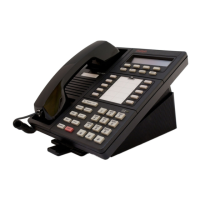MERLIN LEGEND Communications System Release 6.1
System Programming Guide
555-661-111
Issue 1
August 1998
Programming Basics
Page 1-5System Programming Console
1
Console Components 1
Table 1–1 and Table 1–2 provide descriptions of the components that make up
the MLX-20L Console and the Direct Station Selector (DSS). Refer to Figure 1–1
for the location of the components.
Table 1–1. MLX-20L Console Components
Component Function
Desk Stand
(not shown)
An adjustable stand on the console and the DSS, allows a 20- or
30-degree viewing angle.
Button Labeling
Cards
Cards labeled with the number or feature assigned to each line button.
Contrast Control
(not shown)
A sliding control at the top of the console, used to brighten or dim the
display screen.
Fixed Feature
Buttons
Eight fixed display buttons for most-used features.
Feature for viewing the Feature screen and selecting features.
HFAI (Hands-Free Answer on Intercom) for answering voice-announced
calls without the handset.
Mute for turning the speakerphone’s microphone on and off.
Speaker for talking on a call through the speakerphone without lifting
the handset.
Transfer for sending a call to another telephone.
Conf for adding a line or extension to a conference call.
Drop for disconnecting an extension or line from a conference call.
Hold for putting a call on hold.
Dialpad Number pad for dialing telephone numbers.
Direct Station
Selector (DSS)
A device that adds extension buttons and other buttons to the console.
See Table 1–2
.
Display Buttons Four fixed display buttons and 10 unlabeled buttons used to view the
different screens and select names, features, and options from the
display screen. See “Console Buttons” on page 1–7
.
Display Screen Screen with a 7-line by 24-character display area that shows call
information, features, prompts, date, and time.
Handset The hand-held part of the console you pick up, talk into, and listen from.
LEDs (Light-Emitting Diodes) The lights on the console that assist in checking
feature status.
Line Buttons Twenty buttons to make and receive calls; unlabeled buttons are
programmable for one-step feature use.
Message Light A red light that signals a waiting message.
User Cards
and Tray
A slide-out drawer with erasable cards for noting telephone numbers
and feature codes.
Volume Control A button for adjusting the volume of the speaker, handset, headset, and
ringer.

